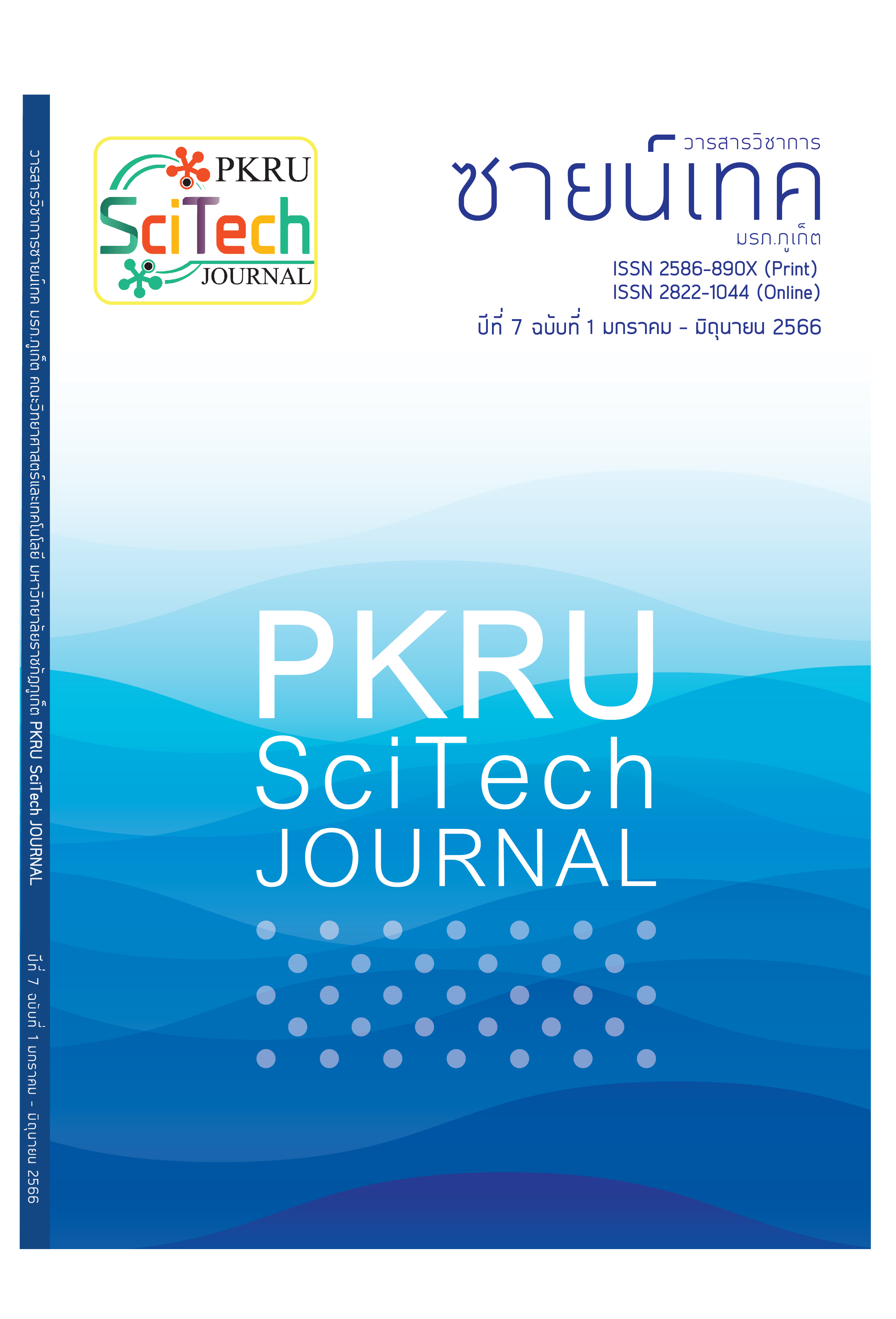การประยุกต์ใช้แป้งรำข้าวปกาอำปึลสกัดน้ำมันในผลิตภัณฑ์คุกกี้
Main Article Content
บทคัดย่อ
งานวิจัยนี้ศึกษาและพัฒนาผลิตภัณฑ์คุกกี้แป้งรำข้าวปกาอำปึลสกัดน้ำมันทดแทนแป้งสาลีบางส่วน โดยแป้งรำข้าวปกาอำปึลสกัดน้ำมันที่ผลิตได้มีองค์ประกอบทางเคมี ประกอบด้วยความชื้น โปรตีน ไขมัน เถ้า คาร์โบไฮเดรต และใยอาหารร้อยละ 5.69, 16.07, 10.80, 9.92, 57.52 และ 6.66 ตามลำดับ พบปริมาณสารแกมมา-โอไรซานอล 0.115 มิลลิกรัมต่อ100 กรัม และกิจกรรมต้านอนุมูลอิสระ 63.69 มิลลิกรัมต่อ 100 กรัม เตรียมผลิตภัณฑ์คุกกี้ที่ใช้แป้งรำข้าวปกาอำปึลสกัดน้ำมันทดแทนแป้งสาลี 5 ระดับ คือ ร้อยละ 0, 10, 20, 30 และ 40 ทำการประเมินคุณภาพทางประสาทสัมผัสด้วยการทดสอบความชอบจากผู้ทดสอบกึ่งฝึกฝน จำนวน 30 คน สามารถคัดเลือกผลิตภัณฑ์คุกกี้แป้งรำข้าวปกาอำปึลสกัดน้ำมันทดแทนแป้งสาลีร้อยละ 40 โดยผลิตภัณฑ์คุกกี้มีองค์ประกอบของเถ้าและใยอาหารสูงขึ้นร้อยละ 2.18 และ 2.86 มีปริมาณสารแกมมา-โอไรซานอล 0.068 มิลลิกรัมต่อ 100 กรัม และกิจกรรมต้านอนุมูลอิสระ 30.75 มิลลิกรัมต่อ 100 กรัม จากการตรวจสอบทางกายภาพ พบว่า ความสว่าง (L*) ของผลิตภัณฑ์คุกกี้มีค่าลดลงเมื่อปริมาณแป้งรำข้าวปกาอำปึลสกัดน้ำมันเพิ่มขึ้น และค่าปริมาณน้ำอิสระ (aw) มีค่าเพิ่มขึ้นจาก 0.19 เป็น 0.35 เมื่อตรวจสอบทางจุลินทรีย์อยู่ในเกณฑ์มาตรฐานผลิตภัณฑ์ชุมชน: (คุกกี้ มผช.118/2555) ที่กำหนดไว้ไม่เกิน 1 x 106 โคโลนีต่อตัวอย่าง 1 กรัม
Article Details

อนุญาตภายใต้เงื่อนไข Creative Commons Attribution-NonCommercial-NoDerivatives 4.0 International License.
- เนื้อหาต้นฉบับที่ปรากฏในวารสารเป็นความรับผิดชอบของผู้เขียน ทั้งนี้ไม่รวมความผิดพลาดอันเกิดจากเทคนิคการพิมพ์
- ลิขสิทธิ์ต้นฉบับที่ได้รับการตีพิมพ์ในวารสารวิชาการ ซายน์เทค มรภ.ภูเก็ต ถือเป็นกรรมสิทธิ์ของวารสารวิชาการ ซายน์เทค มรภ.ภูเก็ต
เอกสารอ้างอิง
Jiratchaya W, Chaiwat A, Apinya S, Mintra S, Warintorn R, Chanakan P., & Korawan S., (2022). Comparative analysis of nutritional components and phytochemical attributes of selected Thai rice bran. Frontiers in Nutrition, 9, 833730.
Moongngarm, A., Daomukda, N., & Khumpika, S. (2012). Chemical compositions, phytochemicals, and antioxidant capacity of rice bran, rice bran layer, and rice germ. Apcbee Procedia, 2, 73–7.
Issara, U., & Rawdkuen, S. (2016). Rice bran: a potential of main ingredient in healthy beverage. International Food Research Journal, 23(6), 2306-2318.
แผนงานฐานทรัพยากรอาหาร สำนักงานกองทุน สนับสนุนการสร้างเสริมสุขภาพ. (2553). มหัศจรรย์พันธุ์ข้าวพื้นบ้านคุณค่าทางโภชนาการของสายพันธุ์ข้าวท้องถิ่น. [ออนไลน์], สืบค้นจา https://prachatai.com
/journal/2008/09/18027 (14 ตุลาคม 2565).
Garsa, A. (2020). Preparation and nutritional properties of cookies from the partial replacement of wheat flour using pumpkin seeds powder. World Journal of Environmental Biosciences, 9(2), 48-56.
Allen, T. A., Quast, E., Bertran, L. C., & Balny, E. M. (2016). Partial substitution of wheat flour with taro (Colocasia esculenta) flour on cookie quality, Revista de Ciências Exatas e Naturais, 18(2), 202-212.
นวพร ลาภส่งผล นันทิดา บุญเสงี่ยม และ ดวงหทัย ใจเสาร์. (2559). ผลของการทดแทนแป้งสาลีด้วยโปรตีนกากถั่วเขียวต่อคุณภาพของคุกกี้เนย. วารสารวิทยาศาสตร์เกษตร, 47(2)(พิเศษ), 293-296.
Norhidayah, M., Noorlaila, A., & Nur Fatin Izzati, A. (2014). Textural and sensorial properties of cookies prepared by partial substitution of wheat flour with unripe banana (Musa x paradisiaca var. Tanduk and Musa acuminata var. Emas) flour. International Food Research Journal. 21(6), 2133-2139
อริสรา รอดมุ้ย และ อรอุมา จิตรวโรภาส. (2550). การผลิตคุกกี้โดยใช้แป้งข้าวหอมนิลทดแทนแป้งสาลีบางส่วน. วารสารเทคโนโลยีการอาหาร, 3(1), 37-43.
คงศักดิ์ ศรีแก้ว, เฉลิมพร ทองพูน, ธวัชชัย ศุภวิทิตพัฒนา, ปิยวรรณ ศุภวิทิตพัฒนา, และเมธาวนี ประดิษฐ์. (2553). กระบวนการอย่างง่ายในการเพิ่มผลผลิตและปรับปรุงคุณภาพน้ำมันรำข้าวบีบเย็น. วารสารวิจัยเพื่อการพัฒนาเชิงพื้นที่, 2(6), 43-52.
AOAC. (2012). Official method of analysis (19th ed). Washington DC: The Association of Official Analytical Chemists Inc.
Perretti, G., Miniati, E., Montanari, L., & Fantozzi, P. (2003). Improving the value of rice by-products by SFE. Journal of Supercritical Fluids, 26, 63-71.
Kwaw, E., Ma, Y., Tchabo, W., Apaliya, M. T., Wu, M., Sackey, A. S., & Tahir, H. E. (2018). Effect of lactobacillus strains on phenolic profile, color attributes and antioxidant activities of lactic-acid-fermented mulberry juice. Food Chemistry, 250, 148-154.
Ugwuona, F., Ukom, A., Ejinkeonye, B., Obeta, N., & Ojinnaka, M. (2021). Exploring the possibilities of some selected flour blends for the development of bakery products: Comparison with some physicochemical and functional properties of wheat flour. Food Science and Technology International, 29(2), 105-114.
Chopra, N., Dhillon, B. Rani, R., & Singh, A. (2018). Physico nutritional and sensory properties of cookies formulated with quinoa, sweet potato and wheat flour blends. Current Research in Nutrition and Food Science, 6(3), 798-806.
Gani, A., Wani, SM., Masoodi, FA., & Hameed, G. (2012). Whole-grain cereal bioactive compounds and their health benefits: a review. Journal of Food Processing & Technology, 3(3), 1000146.
บุญยกฤต รัตนพันธุ์, วัชระ สิงห์หง, อเนก หาลี, พิมพ์ชนก พริกบุญจันทร์. (2560). การพัฒนาผลิตภัณฑ์คุกกี้จากรำข้าวหอมนิล (หน้า 233-239). ใน การประชุมวิชาการระดับชาติของมหาวิทยาลัยราชภัฏกาญจนบุรี ครั้งที่ 2. กาญจนบุรี.
Gunstone, F. (1996). Fatty acid and lipid chemistry. New York: Chapman & Hall.
วิวัฒน์ หวังเจริญ. (2010). แอคติวิตี้ของน้ำและการศึกษาอายุการเก็บรักษาของอาหารแห้ง. Food, 40(4), 277-281.
Neeta, K., Neelam, K. V., & Priyanka R. (2018). Nutrient composition of full fat and defatted rice bran. Asian Journal of Dairy and Food Research, 37(1), 77-80.
Mishra, N. (2017). Utilization of waste defatted rice bran in formulation of functional cookies and its effect on physiochemical characteristic of cookies. International Journal of Advanced Science and Research, 2(5), 64-6.
Sudha, S., Gopala, K., & Asna, U. (2011). Physio-chemical characteristics of defatted rice bran and its utilization. Journal of Food Science and Technology, 48(4), 478–483.
Kalpanadevi, C., Vasudeva, S., & Subramanian, R. (2018). Influence of milling on the nutritional composition of bran from different rice varieties. Food Science and Technology, 55(6), 2259–2269.
สำนักงานมาตรฐานผลิตภัณฑ์อุตสาหกรรม. (2555). มาตรฐานผลิตภัณฑ์ชุมมชน: คุกกี้ 118/2555. มาตรฐานผลิตภัณฑ์ชุมชน.


